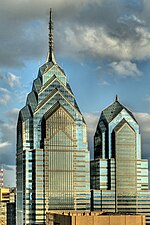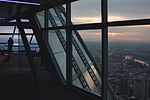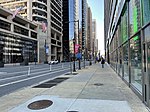Market Street, originally known as High Street, is a major east–west street in Philadelphia. The street is signed as Pennsylvania Route 3 between 38th Street (U.S. Route 13) and 15th Street (PA 611). A short portion of the road continues west from Cobbs Creek Parkway (63rd Street) to Delaware County, adjacent to Philadelphia.
‘High Street’ was the familiar name of the principal street in nearly every English town at the time Philadelphia was founded. But if Philadelphia was indebted to England for the name of High Street, nearly every American town is, in turn, indebted to Philadelphia for its Market Street. Long before the city was laid out or settled, Philadelphia's founder, William Penn, had planned that markets would be held regularly on the 100-foot (30 m) wide High Street. The city's first market stalls were situated in the center of the thoroughfare starting at Front Street and proceeding west eventually to 8th Street. The stalls soon became covered and were not taken down as planned. Later, additional covered sheds appeared west of Center Square as the city expanded westward. The street began to be called Market Street around 1800. The road's new name was made official by an ordinance of 1858, coincidentally, just a year before the market sheds were ordered removed.
Market Street has been called the most historic highway in the United States because of the various historic sites along its eastern section. Many of Benjamin Franklin's activities were centered along Market Street. His house was located near the intersection of Fourth Street, and he may have performed his famous kite-flying experiment near Third and Market Streets. Thomas Jefferson wrote the Declaration of Independence in a boarding house (the Graff or Declaration House) once located at the Seventh Street intersection. The mansion of Robert Morris, financier of the American Revolution, was located near Sixth and Market Streets. This house, known as the President's House, was used by George Washington and John Adams as their residence during their terms as president. (The house was more or less on the site of the northern part of the modern-day Liberty Bell Center.) Around 1795 Theophilus Cazenove lived at Market Street. Several important finance and publishing firsts also occurred along Market Street between Second and Fourth Streets during the 18th century. Market Street is still one of the principal locations of business and commerce in Philadelphia.
On June 5, 2013, a building collapsed at 22nd Street, trapping a number of people under the rubble. Six people died and fourteen others were injured. The location of the accident has been dedicated as a memorial for the victims.









